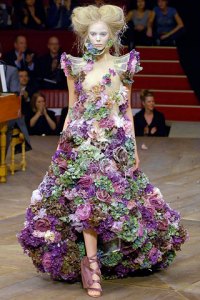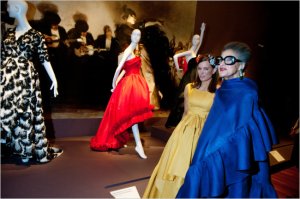Is Fashion Art?
by Elyssa Jechow
Famed French couturier Paul Poiret once said, “I have always liked painters. It seems to me that we are in the same trade and that they are my colleagues.” Yet fashion has had to struggle to gain that “collegiality” among the arts, being also seen as “the bastard child of capitalism and female vanity,” according to Valerie Steele, Director and Chief Curator of the Museum at the Fashion Institute of Technology. French philosopher Gilles Lipovetsky indicates a rough road for fashion as he opines similarly, “Like science and industry, fashion is one of the faces of modern artifice, of the effort of human beings to make themselves masters of their own existence.” A poor statement of an art form, if it is such.
Fashion holds a valid claim to status as an art. Great couture requires a creative mind (think Alexander McQueen, Valentino Garavani), skilled craftsmanship involved in the making of any garment, and the creative use of media (from fabric and sequins to even trash and raw meat). Fashion trends have at many times followed artistic trends, and the bond between the visual arts and fashion design during the Art Nouveau period, for example, is undeniable.
Fashion is also for the consumer. The rise of global capitalism and the establishment of the assembly line have made fashion available to the masses. Styles and brand names serve to convey social status. Whereas “styles of music and painting might evolve in pursuit of truth and ultimate form…the fluctuating styles of the skirt…are seen to merely entice the gullible or put down the hoi-polloi” (Virginia Postrel, Wall Street Journal http://online.wsj.com/article/SB10001424052748703453804575479902076411376.html). There is some truth to that statement. If the industry decides it wants to sell us something, it uses a variety of media to convince us we need it: a strut down the runway at any major fashion week event, a celebrity endorsement, and now even affordable designer lines at discount stores like Target and Wal-Mart.
My answer to the critical question, though, would be a bit more ambiguous, and given a little time for contemplation, I could give an answer I’d be satisfied with. There are some truly brilliant minds that have graced the world of fashion and made it their own art form. In my mind, McQueen has been the greatest of these – his posthumous solo exhibit at the Met received rave reviews, and justifiably so. The art institution has recognized other designers with their own exhibits. A relatively recent issue of Vogue did a spotlight on the “Balenciaga and Spain” exhibit at the de Young Museum in San Francisco, and the Roberto Capucci “Art into Fashion” exhibit at the Philadelphia Museum of Art was a smash.
I suggest some different terms, though. Aside from the actual medium (if we want to call it that), I’ve come to see fashion as an outlet of sorts for other forms of art – maybe as sort of an avenue for cultural movement. We certainly saw that happen in the 1920s when women bared their legs and cut their hair and in the 1960s when hippie style was surely definable. Notable First Ladies like Jackie Kennedy and Michelle Obama have used fashion politically. We can name the grunge movement, the “hipster,” the list could go on…
Fashion, I think, also enables art – a different type of cultural movement, more thoughtful. In September of 2010, New York Fashion week opened at the Lincoln Center – but it wasn’t only to be runway shows that year. Throughout the duration of the rest of the year, the new director of fashion at the center organized events like opera, theater, dance and music, fashion films, photo exhibits and lectures.
At the turn of the century (the last one), fashion press employed fine artists to illustrate the designs of the day. Today, contemporary art’s most famous photographers (think Annie Leibovitz) are regularly hired by the fashion press. There was a fascinating picture story In W magazine’s November 2011 “Fashion Meets Art Issue.” “Ai Weiwei Enforced Disappearance: An Exclusive Collaboration with China’s Most Wanted Artist” was the imprisoned (under house arrest) Chinese artist’s first work since being released from government custody. Weiwei Skyped in on the shoot from his studio in China and directed the crew as they shot on Rikers Island and in New York City. The story commented on conflicts between individuals and authorities, the model was dressed in Alexander Wang. Fashion enables art.

Scott Schuman, street style extraordinaire, fuses photography and fashion. He finds inspiration in the likes of all – even a street vendor.
In very recent years, photography has enabled fashion to become a kind of street art. “Street fashion” blogs like The Sartorialist, Face Hunter, Garance Doré, and countless others have inspired fashion aficionados to look to the streets to increase their style savvy. Photographing both fashion icons and unknowns in their street clothes, the blogs provide inspiration for the creative, expressive dresser. In fact, The Sartorialist photographer and blogger Scott Schuman was named as one of Time Magazine’s Top 100 Design influences. And though some of these particular blogs have become quite famous worldwide, there are also thousands of fashion bloggers photographing inspirational styles on the street, posting blog entries, and making an impact on the fashion and self-expression of their readers.
Back to our original question: Is fashion art? The question defies an easy answer because what we wear also crosses into the world of commodity and craft. To some, it’s an industrial machine, designed to trick people into dumping exorbitant amounts of money on non-essentials. Yet to others, it ranks right up there with painting, sculpture, and the opera. This dual nature points to a gray area. No matter how we look at it individually, though, it is fact that the fashion world and the art world are most definitely woven rather tightly together. Both institutionally and in less formal forms, fashion and art collide, and I believe, will continue to move along a continuum together as contemporary art progresses and evolves.
For related articles from The Muse Dialogue:
Fashion in the Arts: A Powerful Collaboration of Creative Minds













“To some, it’s an industrial machine, designed to trick people into dumping exorbitant amounts of money on non-essentials.”
The same could be said for fine art.
Non-essential? Yes.
Exorbiant amounts of money? Yes.
Industrial machine? Yes.
That doesn’t mean it’s not art, still.
Good article.
Few other forms of art have the power to inspire in daily life the way fashion does. Ultimately, the inspiration on the runway works its way down an into the lives of everyone. You are right: it really is FOR consumers in a more direct way than many other art forms.
Fashion is art. It is often an abstract thought and only through creativity does it become a reality. It is also incredibly expressive. You can often see the emotion right in the design. Plus consider the creative twist one can do just by adding a pop of color with an accessory. Your whole outfit can speak a 1,000 words and that to me is art.